Key factors to help or hurt home prices
Industry experts outline the biggest issues facing the Aussie real estate market right now.
Property
Don't miss out on the headlines from Property. Followed categories will be added to My News.
After a whirlwind year of rate hikes, cost of living pressures and rental strife, economists and real estate experts are watching the Australian property market carefully to see what happens next.
Here are some of the big issues facing the property market in 2024.
INTEREST RATES
REIA president Leanne Pilkington said economists are divided as to whether interest rates will start to fall after almost two years of RBA hikes.
“A lot of people are saying interest rates have peaked and potentially will start going down in the second half of this year,” Ms Pilkington said.

PropTrack economist Anne Flaherty said if interest rates hold steady or begin to fall throughout 2024 it could help to restore buyer confidence following two years of uncertainty, which could in turn support further price growth through an increase in demand.
“The fact that interest rates have increased so much, so rapidly, really drove a big drop in sentiment,” she said.
“People had a lot of uncertainty about how much their repayments were going to be.”
But while inflation has come largely under control, international conflicts could push it, and therefore interest rates, back up again, REBAA president Melinda Jennison from Streamline Property Buyers said.
“It can also have a huge impact on consumer confidence,” she said.

IMMIGRATION
With the federal government last year announcing plans to halve immigration by 2025, population growth is expected to be slower than the “incredible levels” seen in 2023, Ms Flaherty said.
But while less migrants are expected to enter the country this year, population growth is still expected to be strong enough to put further pressure on the property market – particularly the rental market in our major capital cities, she added.

RENTAL CRISIS
Ms Pilkington said more investors had exited the market last year and could continue to do so following the spate of interest rate hikes, which could add to the shortfall in rental supply.
“There’s just not enough properties to rent,” she said.
Ms Flaherty said with vacancy rates sitting close to record lows across the country, it was most likely rents would continue to rise throughout 2024, albeit at a more moderate pace than the 11.5 per cent seen last year.

HOME BUILDING INITIATIVES
While there are home building incentives in place, the supply pipeline is very slow and not likely to make a significant dent in the supply shortage this year, Ms Jennison said.
“Building approvals in the last 12 months alone are down in both detached and attached dwellings, so it’s certainly not on target at all for the number of people that need homes,” she said.
Ms Flaherty said not only has there been a reversal of the dwelling approval surge brought about by the Homebuilder incentive during Covid, there has also been a slowdown in new construction starts. Skyrocketing construction costs have stalled apartment developments, reducing the number of new homes at lower price points entering the market.

KEY MARKET DRIVERS IN 2024
*Interest rates – steady or falling rates in 2024 could improve consumer confidence and drive high demand
* Cost of living – soaring inflation throughout 2024 has left many Australians with less take home pay at the same time mortgage repayments have risen, affecting their borrowing power and ability to purchase property
* Investors – cost of living and interest rate pressures have prompted many investors to sell their properties, reducing available rental stock but potentially adding to sales listings
* Immigration – a drop in immigration could mean less demand in the rental market yet experts say population growth will likely be strong enough to push rents up as vacancy rates sit near record lows
* Building approvals – a slowdown in building approvals and construction starts will exacerbate a chronic lack of supply, potentially adding to price growth
* Supply and demand – localised markets with strong demand and less supply will likely continue to see price growth this year, such as Perth, Brisbane and Adelaide, while those with more listings and less buyers will see less price growth, such as Sydney, Melbourne, Hobart and Canberra.
More Coverage
Originally published as Key factors to help or hurt home prices




